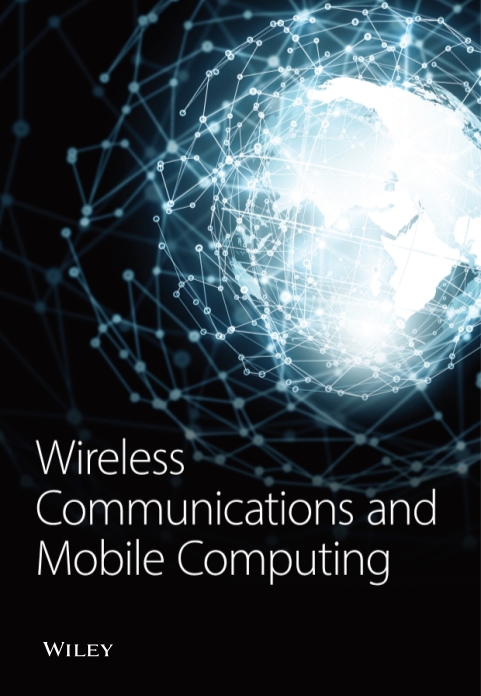[Retracted] A Novel Model of Network Ideological Education in Universities Based on Learning Analysis for the Era of 5G Mobile Computing
Abstract
Internet 5G introduces new methods and carriers for NIE (network ideology education) and marks a new milestone in multicarrier linkage and multichannel university NIE education, combining the benefits of emerging and traditional media. The specific intervention strategies for college students’ online learning procrastination are calculated in this paper, and a learning analysis-based implementation framework for college students’ online learning procrastination intervention is built. The K-means algorithm is used to analyze learning style; additional contextual information, such as student-knowledge point mastery and lesson-knowledge point, is added using the CF (collaborative filtering) algorithm, and students’ mastery is predicted using the excavated learning path. Experiments show that adding more data improves the prediction effect, especially in terms of operation efficiency. At the same time, the proposed framework can not only dynamically assess students’ knowledge mastery but also facilitate systematic review feedback and learning order adjustment, as well as provide personalized learning services.
1. Introduction
Ideological work, as the fine tradition and political advantage of the Party, has always been the lifeline of all work in China. It is precisely because advanced and active ideological work constantly guides China’s development and constantly breaks through various obstacles that it can show the trend of rapid economic and cultural development after the reform and opening up [1–3]. With the rapid replacement of intelligent terminals, the number of people involved in the mobile network will become larger and larger. The existence of such a huge social network group makes us have to think about the profound influence and changes that the mobile Internet is bringing to our study, work, and life [4]. People’s texting and making phone calls through smart terminals will become obsolete in the near future, and mobile phones must be equivalent to computers. The ideological education reform under the network perspective is imminent in order to actively respond to China’s Internet reform. It is critical to understand the importance and necessity of NIE (network ideology education) in the new era, as well as the characteristics of ideological education from an Internet perspective [5].
The 21st century is the 5G era, the information era, and the era of rapid development of Internet technology. With the rapid development of information technology, earth-shaking changes have taken place in many fields, the traditional media has been reformed, and the Internet came into being [6, 7]. On the one hand, it brings opportunities to university NIE; on the other hand, it also poses new challenges to university NIE. Therefore, universities should constantly strengthen students’ ideological education and guide students to establish correct values. College students are the motherland’s future successors, bearing the heavy responsibility of building the motherland, and ideological education is the university’s primary task [8]. Individualization emphasizes each person’s uniqueness, and the learner model can be used to reflect differences and characteristics among students. As a result, the learner-based model is capable of providing a variety of personalized services [9]. Online learning has realized the tracking and recording of learners’ learning behavior data in a complete system, as a modern educational form in the process of education actively adapting to and promoting the development of educational informatization. The curriculum is evaluated, and the whole class or individual students are diagnosed using learning analysis technology. It has been accepted by the public and has gradually become a mainstream learning method [10, 11]. With the research on students’ behavior patterns being widely concerned, how to model students’ behavior and describe their behavior characteristics accurately and comprehensively is an important issue to be considered.
Teachers should take an active role in guiding students and attempting to mitigate the negative effects of Internet technology. Following the 4G network, the 5G network has achieved trial networking, and the faster and more convenient network era is rapidly approaching. Under the new circumstances, NIE work in universities will inevitably face new challenges, as well as new work ideas and methods [12]. As a result, there is room for exploration in both time and space with this topic. This paper provides theoretical support and practical guidance for university research on NIE innovation in the new era of Internet 5G, as well as a deeper understanding of its social value and future development trend, in order to promote its long-term and effective development.
2. Related Work
Literature [13] explains how to apply network thinking to a wide range of tasks, as well as how to implement strategies and tactics to counteract outdated thinking. Literature [14] compares traditional networks, analyzes the former’s new concepts and features, and delves into the mobile Internet’s development trend. Teachers benefit greatly from internet-based learning. According to the literature [15], cloud technology, Internet of Things, and data information based on cloud technology and Internet of Things have become a new learning resource and support in the era of mobile Internet. Universities should rethink their teaching methods, develop a new teaching platform based on mobile Internet, seize teaching initiative, and create a new environment for ideology teaching in universities. According to literature [16], educators must grasp the influencing factors of improving teaching effectiveness, effectively use mobile Internet technology, improve their own media literacy level, and continuously improve the effectiveness of teaching reform in the new environment. According to literature [17], due to the impact of the mobile network on the classroom, some of them are hard-wired into the mobile network classroom to some extent in order to adapt to the new trend, and a teaching method based on the mobile network is constructed. To some extent, the mobile internet can encourage teachers to switch roles and emphasize the benefits of different teaching methods. Literature [18] holds that the current network technology is advancing step by step and constantly extending the communication channels and spatial patterns, while various communication channels and development technologies are promoting the development of ideology in the media. Literature [19] points out that the new media similar to mobile Internet pays more attention to the individuality of people.
In literature [20], through research, it is found that 95% of college students have obvious procrastination when completing their tasks, and 50% of students will wait until the deadline to finish their academic tasks. Literature [21] research results show that 46% of college students have certain delays in completing their papers, 30.1% of college students delay in completing routine tasks, and 27.6% of college students delay in preparing for exams. Literature [22] research shows that task aversion is an important reason that affects academic delay. People often avoid the stimulation of unpleasant physical examination, and even if they cannot avoid it, they will delay the start time of the task. Literature [23] research shows that the balance between students’ ability and task difficulty is also an important factor that affects academic procrastination. Students facing tasks that are too challenging or too easy will lead to procrastination. Literature [24] proposed a comprehensive cognitive model, while the application research of the cognitive model is mainly based on a cognitive model or cognitive theory to analyze the cognitive level and estimate cognitive ability. Literature [25] combines the clustering algorithm and a priori algorithm; this paper analyzes the association rules of learning sequence patterns of all kinds of students in courses and recommends the appropriate courses according to their preferred learning paths.
3. Research Method
3.1. Probe into the Creative Path of University NIE in the New Era of Internet 5G
The teaching methods of ideology class are becoming increasingly problematic in the new era of 5G Internet. Teachers of ideology classes must have a thorough understanding of and proficiency with the mobile Internet in order to help students identify information in a complex network environment. As a result, it is critical to place a high value on teachers’ and students’ media literacy when using mobile Internet. It is necessary to alter teachers’ ideologies and beliefs, master and apply mobile network technology, adapt to new communication methods, and make subconscious changes. Simultaneously, teachers in ideology classes should think in terms of mobile networks, abandoning the traditional notion that teachers are authoritative and using mobile network technology to implement interactive and equal teaching methods in ideology classes.
Ideal education is an important part of college students’ ideological education, and it is also an important condition to ensure the direction of students’ growth and success and the successors of the socialist cause. Under the background of Internet 5G, college students have absolute autonomy for the educational content spread in the network. Choosing the content is not “the more the better” but passing the effective content to college students in the new era who need it. To convey correct ideals and beliefs, respect the college students’ sense of subjectivity on the Internet, so as to enhance people’s subjective value. From the perspective of college students, respect their individual differences, adhere to the principle of people-oriented education, and optimize the educational results, so as to guide the majority of college students to form positive and healthy acceptance psychology.
The structure of the university NIE platform is from high level to low level, showing a vertical arrangement. The university NIE platform consists of educators, educatees, contents, carriers, and environment (Figure 1).

These five elements constitute the next level of the university NIE platform structure, and each level is composed of the elements of this level. The high level plays a guiding and regulating role for the low level, and the low level plays a basic supporting role for the high level. If the specific educational content does not meet the inherent requirements of the educational content elements, or the requirements and objectives of the specific educational content are inconsistent, it means that the vertical structure of the educational content is unreasonable.
For college students’ ideological education, excellent Chinese traditional culture provides a wealth of educational resources. To inherit and innovate excellent traditional culture, various media are combined. Educational means are enriched, traditional cultural education content is added, and college students’ cultural confidence in traditional culture is cultivated during the ideological education process. China’s laws, regulations, and other rules and regulations are gradually improving against the backdrop of comprehensively governing the country according to law. University NIE urgently needs to promote rule of law education for college students, increase their awareness of the rule of law, and cultivate their ability and quality of learning, knowing, abiding by, and applying the law. Effectively integrating and applying traditional and emerging media, seizing the initiative of law awareness education, carrying out law education, improving college students’ awareness of the rule of law, and providing a strong guarantee for realizing the goal of “two hundred years” and the Chinese dream of great rejuvenation of the Chinese nation are all important practical and historical considerations.
The ultimate goal of analysis is to improve the learning experience environment by collecting and analyzing data and setting appropriate interventions. In order to structure the process of data collection and analysis, researchers put forward the process of learning analysis in the educational environment from the macrolevel. Campbell and Oblinger put forward five steps of the learning analysis process, including capture, report, prediction [10], function, and improvement, as shown in Figure 2.
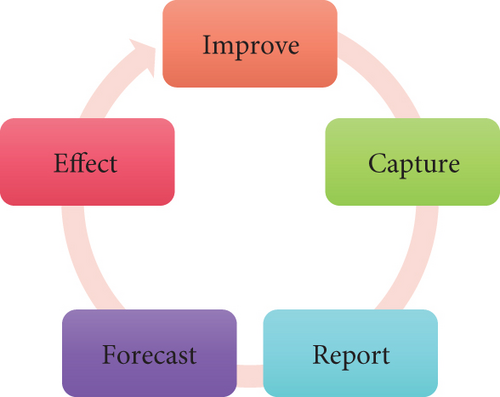
Capture refers to the real-time acquisition and collection of data from different sources combined with students’ basic information; report means that the collected data is used to generate accurate models to identify and measure students’ progress, and the learning and analysis dashboard is usually used to facilitate the visualization of hidden data. Prediction means that data is used to identify students’ success, results, and predictive factors of high-risk students, and it is also used to make decisions on curriculum and resource allocation for educational decision-makers.
From the perspective of the Internet, it is urgent to formulate relevant rules and regulations for ideological work in universities, to master the orientation of campus public opinion, to maintain campus network security, and to strengthen the construction of teachers’ teams through standardized system construction. First of all, in terms of creating an ideological environment, a management and control mechanism for Internet information security in colleges and universities should be established. Secondly, in the aspect of enhancing the attraction of university network ideology, use WeChat Mini Programs to open college and university network ideology courses, WeChat official account, etc., establish the network interaction system of ideology education, and reform and innovate the traditional ideology model. In addition, in order to form and cultivate an ideological work team with excellent quality and excellent style, universities should establish a mutual cooperation system among professional and technical teams of online media, security monitoring teams, and ideological educators, as well as an ideological training system for teachers, head teachers, counselors, and other related personnel of university ideology courses, regularly discuss the problems encountered in the process of ideological education, enhance the ability of ideological educators to carry out ideological work, and fully enhance the effectiveness of ideological education.
The network transmission speed is faster in the 5G era, and the traffic cost may be lower. Its impact is comparable to that of the 4G era, thanks to the emergence of various technologies. If traffic costs are reduced further, traditional words and pictures may lose their advantages in the future, leaving more room for audio and video development. The focus of NIE’s work can also shift from words and pictures to audio and video, with audio and video being used to share news and convey correct ideas. Counselors can use the platform to create discussion topics for students, and students can express their opinions in their spare time. Counselors can learn about the students’ thoughts in real time this way. In addition, counselors should encourage students to discuss some ideologically related topics on the platform, as well as encourage students to participate in the topic discussion of ideological education in all aspects, in order to create an environment conducive to ideological learning.
3.2. Learner Model Analysis
For learners, the learner model serves as the foundation for online learning analysis. Individual attribute information is reflected in learners’ basic information. Due to a variety of growth experiences and backgrounds, different learners will have different learning preferences and behaviors during the learning process. Personal identity-related information and academic basic information are two aspects of learner basic information. In the online learning environment, the use of learners’ academic information is beneficial to realize personalized content and learning path recommendation in the learning process; at the same time, it can also reflect a change in the stage business status; as a result, the basic academic data must be collected and managed.
If students cannot manage their time effectively, it will be easy for them to postpone their tasks. E-mail is sent to remind students to finish their academic tasks on time, to inform students of the current learning situation and time utilization, including a series of information such as a summary of recent studies, the progress of task completion, the remaining time before task submission, the reasonable degree of learning arrangement, and the degree of learning utilization of learning resources, etc. At the same time, appropriate learning suggestions and guidance are provided for different types of students to improve students’ time management ability and reduce the number of delays.
Under the online learning environment, making students actively and effectively participate in learning activities is an effective way to reduce delay. The key characteristics of students’ academic procrastination are diagnosed and identified by learning analysis technology, and the analysis results are presented in figures, charts, and other visual forms by using visualization technology. In this way, you can understand the student’s learning status and diagnose the student’s procrastination. If there is no procrastination in the diagnosis result, the next round of diagnosis will be conducted directly. If there is procrastination in the diagnosis results, students with similar characteristics will be classified by cluster analysis, and personalized intervention will be implemented for students with different characteristics.
In this section, the K-means algorithm is used to analyze learning behavior, so as to analyze learners’ learning style. The specific analysis flow is shown in Figure 3.
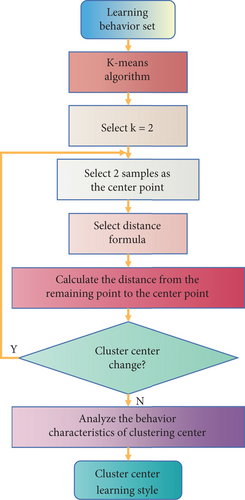
As can be seen from Figure 3, there are three key points in the process of learning style analysis, which are formalization of learning behavior set, formulation of distance calculation, and result analysis.
Through the analysis of C0, C1 learning behavior, the types of C0, C1 learning styles are obtained, and the behavioral preferences of this kind of learning styles are summarized, so as to analyze the learning styles of other learners according to behavioral indicators.
CF (collaborative filtering) technology is one of the earliest and most widely used models in recommendation systems, which use a group of users’ historical preference information to recommend or predict unknown preferences of other users. In real-life scenes, our judgments and choices are often influenced by friends to some extent. In this chapter, a prediction framework of mastery based on learning behavior is proposed, and two CF methods of adding additional information are proposed, namely, adding side information (lesson-knowledge information) and interactive information (learning behavior information of users on knowledge points).
Improve two memory-based CF algorithms, UCF (User-Based Collaborative Filtering) and PCF (Project-Based Collaborative Filtering), and add additional information matrix X to improve the efficiency and accuracy of finding neighbor sets.
Calculate the similarity matrix S based on the student-tag matrix X, and S(i, k) = S(k, i) represents the similarity between students ui, uj. For student ui, the first K are selected as neighbor sets after ranking according to the similarity, and the similarity between neighbor sets and ui is normalized.
Calculating the similarity matrix T based on the lesson-tag matrix Y, T(j, k) = T(k, j) representing the similarity between lesson ci, cj. For class cj, after sorting according to the similarity, select the first K as neighbor set , and normalize the similarity between neighbor set and cj.
In addition to the data of students’ learning behaviors generated in the online learning process, the information of students’ basic information, learners’ styles, learning attitudes, students’ previous experience, and students’ interests cannot be ignored. This information can make teachers know students more accurately and design intervention measures less dependent on experience and intuition, thus improving the accuracy of delaying intervention strategies.
4. Result Analysis and Discussion
Everyone has varying degrees of procrastination tendencies, which are a part of their physiological makeup. Some researchers believe that procrastination is caused by a lack of time management and self-control, but subsequent research has shown that this is not the case. Delays are related not only to people’s personalities, psychological motivation, emotional needs, and desires but also to their ability to self-regulate [12]. During the teaching observation week, Excel forms are used to combine the initial data sets of students’ academic tasks, and the number of students who completed the tasks at different times is analyzed. Students have seven days to complete the task; less than seven days is considered early completion, seven days is considered normal completion, and more than seven days is considered delayed completion. The statistical results are shown in Figure 4.
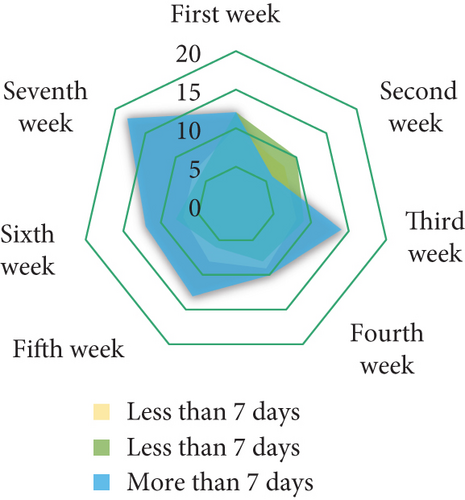
From Figure 4, it can be seen that during the teaching observation week, when students complete tasks such as submitting homework, peer evaluation, and self-evaluation, there are cases where the scheduled time exceeds 7 days; that is, there is a phenomenon of task completion delay.
According to the number of people who have completed the task within the specified time, the number of students’ delays in completing the task is sorted out, as shown in Figure 5.

The number of delays can truly reflect students’ procrastination behavior, and it can be clearly seen that students have some delays in submitting assignments, peer evaluation, and self-evaluation. As the number of instructional weeks increases, so does the total number of delayed assignments by students. The possible reason is that the enthusiasm of students to complete the task decreases with the increase of teaching time, it is difficult to maintain the motivation of learning, and the state of cramming will lead to delays. In this study, the number of procrastination of three types of learners (active participants, intermediate participants, and passive participants) before and after intervention in the online learning process was counted, and the effective rate of intervention in reducing the number of procrastination of three types of learners was analyzed, as shown in Figure 6.
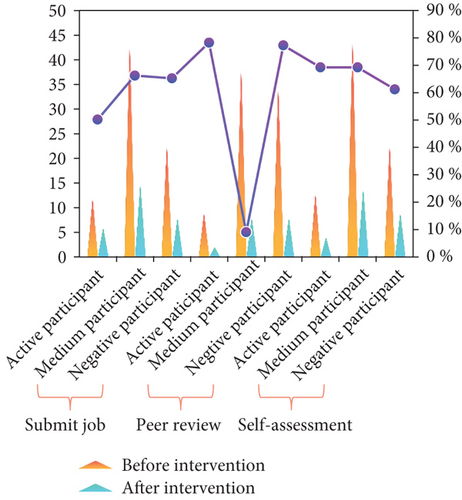
From Figure 6, it can be seen that the implementation of the intervention has significantly reduced the number of procrastination of three types of learners in completing various tasks. Among them, the average participant in the task of submitting homework has the most obvious reduction effect, while the average participant in the task of peer evaluation has the most obvious reduction effect while the active participant has no obvious reduction effect.
It can be seen that the procrastination intervention strategy based on big data learning analysis can effectively reduce the procrastination times of three types of learners, and the intervention guidance effect for middle-level participants is the most remarkable. The analysis reason lies in that active participants have strong autonomous learning ability and pay more attention to the evaluation of their own works than peer evaluation, and the passive participants have more serious procrastination and longer procrastination time. Even though the intervention reduces the procrastination time of the passive participants, they still fail to complete their tasks within the prescribed time limit. At the same time, the average time for each student in the class to complete the three tasks before and after the intervention is compared and analyzed, and the results are shown in Figure 7.
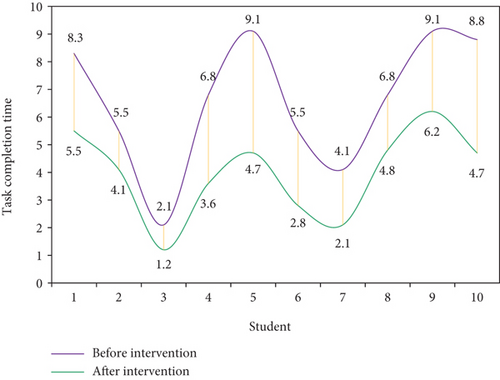
Figure 7 shows that the connection line between the two points of the three students with student ID No.1, No.5, and No.10 is the longest, indicating that these three students have the most obvious intervention effect and the largest time difference before and after the intervention, and the average time to complete the task after the intervention is much shorter than that before the intervention. It has been proven that the intervention effect is significant, and students’ task completion times have improved to varying degrees.
After data standardization, learners’ engagement is calculated according to the above formula, and the distribution results are shown in Figure 8.
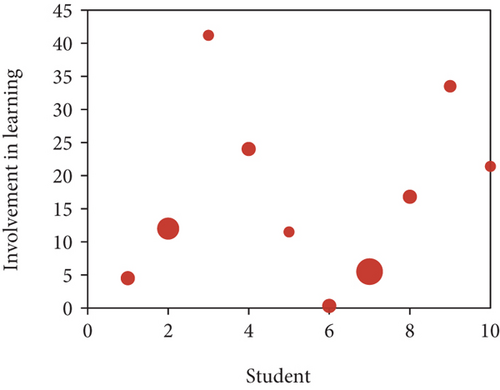
It can be seen from Figure 8 that different learners have different degrees of engagement. Among them, learners 3, 4, and 9 have a high degree of engagement, which indicates that learners spend a long time visiting the course and reflects that learners interact with the course more. However, learner 6’s engagement is low or even zero, which indicates that the time and times of interaction between learners and the course are little, almost none, reflecting that learners’ interaction with the course is less. Through data analysis, it is concluded the formula for calculating learners’ loyalty and engagement, and by analyzing learners’ loyalty and engagement, the learners’ curriculum interaction can be obtained, so the analysis indicators and techniques of interaction behavior characteristics are effective.
In the online social network, the actors are learners and teachers, and the relationship link is forum reply behavior. The online social network is represented by a network diagram, in which nodes represent learners, and the connections between nodes represent the forum reply behaviors among learners. Through social network analysis, the interaction between learners and the individual network position of learners, namely, centrality, are obtained. Further analyze the learner’s degree of centrality, and get the reputation of learners in the learning community. Figure 9 shows the results of Reference [20], UCF, and improved UCF under different neighborhood sizes. The prediction error of improved UCF is lower than that of UCF and Reference [20] on the whole.
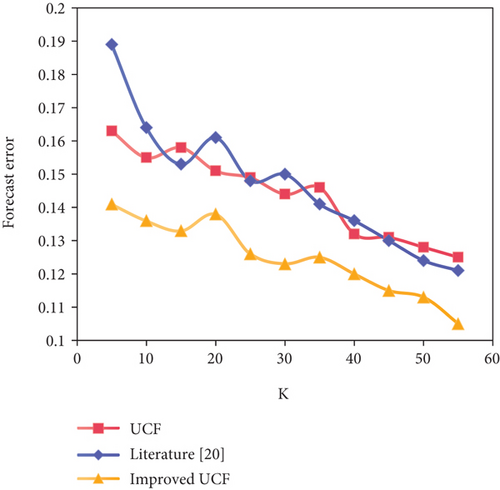
The user’s learning order is often determined by the knowledge topology relationship implied between classes and also influenced by the current learning state. For example, if the current class is not completed correctly, the user may prefer to continue learning the current class. Given the students’ learning level in a certain course and additional information such as learning behavior records, courses, and knowledge points, the students’ mastery is predicted.
Figure 10 shows the results of literature [20], PCF, and improved PCF in different neighborhood sizes. Because the number of items (classes) and labels (knowledge points) in this data set is 12 and 15, the neighborhood range explored in the figure is set to 2 to 110. The running time of the improved PCF is lower than that of PCF and literature [20].

The experimental results show that using additional information in the CF algorithm improves prediction effect and running time. The degree of mastery and the time factor have a strong relationship. The degree of memory for learning content decreases as the time interval lengthens, while the endurance of memory for learning content increases as the learning time lengthens. As a result, the learning path-based evaluation method proposed in this chapter is more effective in measuring prediction results.
Under the background of “Internet,” ideological teachers in higher vocational colleges can get more teaching resources, thus enriching ideological classroom teaching and making the classroom more lively and interesting. At the same time, teachers can guide students to discuss recent hot social issues and help students better understand the socialist core value system, and the classroom teaching atmosphere is relatively relaxed and happy, which is conducive to students’ mental health and physical and mental development, and also encourages students to shoulder the heavy responsibility of national rejuvenation.
5. Conclusion
The arrival of the 5G network is just around the corner, making people’s lives easier, and network ideology work in universities will also bring about new changes. During the teaching intervention week, students with similar behaviors are classified using cluster analysis, and three types of learners are identified: active participants, intermediate participants, and negative participants, with personalized intervention based on the classification results. In an online learning environment, a multidimensional learner model is proposed, and the learning style is analyzed using the K-means algorithm. The mastery prediction framework proposed in this study not only has good applicability to system feedback, such as recommending personalized learning content and adjusting learning order for students, but also dynamically evaluate students’ mastery of knowledge. We learn about students’ subjective evaluations of procrastination intervention through interviews, and we discover that the majority of students are generally satisfied with the implementation of the online learning procrastination intervention strategy, confirming the effectiveness of the intervention strategy.
Conflicts of Interest
The author does not have any possible conflicts of interest.
Open Research
Data Availability
The data used to support the findings of this study are included within the article.



